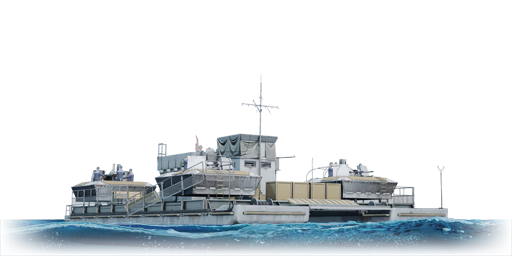



The Siebelfähre 40 (Siebel ferry 40), or just the SF40 for short, was a series of 200 shallow-draft catamaran landing craft developed by the Wehrmacht in 1941. Originally intended to be used for the planned invasion of the United Kingdom, it was later repurposed into a variety of roles: troop transport, ad hoc gunboat, floating flak battery, towed convoy escort, or even as a minelayer. Due to its simple design, the SF40 could be easily converted back and forth to fit various needs. The in-game "SF40 Light" is based on the specific SF40 outfitted with four quadruple mounts of 20 mm anti-air autocannons deployed in Lahdenpohja on the Finnish-Soviet border.
Introduced in Update 1.79 "Project X" in the fleet closed beta test as the SF40 Leichte. The SF40 Light is placed after its heavy counterpart because it is armed with sixteen 20 mm autocannons, with up to twelve that can be targeted at a surface target at a time. This allows the SF40 Light to shred almost every boat or aircraft unfortunate enough to be within its sight within a few seconds. However, being equipped only with small-calibre autocannons, the SF40 Light often struggles against vessels with "detailed" damage models that start to appear at its BR range, with early destroyers in particular posing its greatest threat. Nevertheless, the SF40 is still capable of dominating close-quarters combat with a combination of situational awareness and good positioning.
| Belt | Belt filling | Armor penetration (mm) at a distance: | |||||
|---|---|---|---|---|---|---|---|
| 10 m | 100 m | 500 m | 1000 m | 1500 m | 2000 m | ||
| AP-T/AP/HEF-T/HEF | 36 | 35 | 29 | 24 | 21 | 18 | |
| AP/AP-T/AP/HEF | 36 | 35 | 29 | 24 | 21 | 18 | |
| HEF/HEF-T/HEF/AP | 36 | 35 | 29 | 24 | 21 | 18 | |
| Belt | Belt filling | Armor penetration (mm) at a distance: | |||||
|---|---|---|---|---|---|---|---|
| 10 m | 100 m | 500 m | 1000 m | 1500 m | 2000 m | ||
| AP-T/HEF-I | 67 | 64 | 55 | 47 | 41 | 37 | |
| HEF-I/HEF-I/HEF-I/HEF-I/AP-T | 67 | 64 | 55 | 47 | 41 | 37 | |
| AP-T/AP-T/AP-T/AP-T/HEF-I | 67 | 64 | 55 | 47 | 41 | 37 | |











Seakeeping |
|---|
Unsinkability | |
|---|---|
Firepower | ||
|---|---|---|